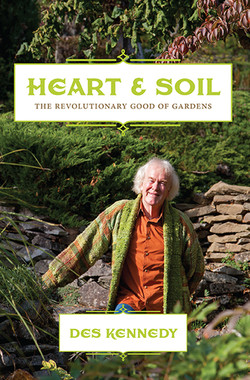Читать книгу Heart & Soil - Des Kennedy - Страница 11
На сайте Литреса книга снята с продажи.
ОглавлениеWild Pursuits
Nothing stimulates the designing gardener’s imagination more agreeably than an extended ramble through wild places. Nurseries, garden shows, tours and similar events all have their purposes, but none quite compares with the ancient wisdom to be gleaned from Mother Earth herself.
Long ago, garden master Lien-Tschen wrote: “The art of laying out gardens consists in an endeavour to combine cheerfulness of aspect, luxuriance of growth, shade, solitude and repose in such a manner that the senses may be deluded by an imitation of rural nature.” Subscribing to a similar philosophy, Sandy and I took ourselves off for several weeks in March to absorb what we could of nature’s late-winter beauty before the crush of our spring planting.
On Whidbey Island in Washington State’s Puget Sound, we camped alone in a mature Douglas fir forest. Spaced widely apart, the stout old firs rose through a dense understorey of salal, the native broad-leafed shrub whose glossy green leaves are used in commercial floral arrangements. Growing in impenetrable thickets two metres tall, the salal formed softly undulating waves of green against which the emergent boles of the firs showed vividly. The kind of effect you could spend forever trying to achieve with clipping and shearing.
Walking along high sea cliffs in the same park, we frequently stopped to admire the gnarled limbs of firs dwarfed and twisted by wind. Increasingly, gardeners are recognizing the values of dead and dying “wildlife trees” as habitat for insects and the birds that feed on them, as well as for the various creatures that nest in their cavities. The gnarled sea-cliff firs, clinging to life in the teeth of wind and drought, reminded us that even in their extended death throes, old trees can be extraordinarily beautiful.
We hiked along headlands where grassy banks dropped a great depth to the sea, the smooth clarity of their descent as satisfying as a freshly mown lawn, contrasting with the sweep of water in a pleasing interplay of vivid green and shining blue surfaces. Sprawled on the grass of a high vantage point, we gazed down over an intensely farmed prairie defined by an unequivocal line where old-growth forest butted up against a meticulously tilled field. No feathering or buffering or gradual transitions here; rather the shaggy complexity of the forest cheek-by-jowl with the immaculate field, a stunning symmetry of opposites.
Barely surviving Friday-night rush-hour traffic through Seattle, we streaked southward toward Portland, then swung east through the Columbia Gorge, following the great river upstream into the high desert country of central Oregon. Here we entered a landscape of rolling sagebrush plains and immense lava buttes, almost as removed as we can get from the dripping rain forests of home. In this parched and windswept terrain, the landscape lessons were less by way of the startling contrasts we’d been captivated by on Whidbey, and more the subtle compatibilities deserts specialize in.
Junipers are widely admired for their hardiness and beauty—we have a few small specimens in the garden at home—and so we were delighted to find ourselves now camping in the largest old-growth juniper forest on the continent. Although many hundreds of years old, these juniper trees were generally less than ten metres tall, but exceptionally fine. Their densely packed blue-green needles showed stunningly against the silvery grey of sagebrush and bleached desert grasses.
Hiking along the base of a high lava butte, we came upon an enchanted wild garden of junipers growing amid enormous rocks that had tumbled from the butte and settled in patterns of casual perfection any rock gardener would drool to duplicate. At one spot, a huge rock was cleft entirely open, as though by the hand of a wrathful Jehovah, its twin sundered sections lying like an open book with a big juniper tree emergent between the two. You couldn’t help but think of sacred places and events, precisely the kind of feeling the best of gardens excite.
Last year’s juniper “berries” (they’re actually fleshy female cones) created all sorts of pleasing effects. In places, they littered the ground under the trees, a vivid embroidery of plummy blue. We saw them scattered among tiny, yellow-blooming ephemerals, and in another spot mingled with small pink wildflowers whose name we didn’t know. Both compositions were exquisite. So was the combination of berries still massed on junipers alongside rusty-orange catkins dangling from small alder trees growing on a riverbank. The berries and catkins together, with silvery sagebrush beneath, formed a simple yet splendid tableau.
The point for the gardener, of course, is not to try to duplicate these wild arrangements, but rather to absorb a sense of them, a feeling for how entirely correct they are in their place, and to have that sensibility inform our efforts as we move, however haltingly, toward gardening in harmony with natural landscape patterns.
